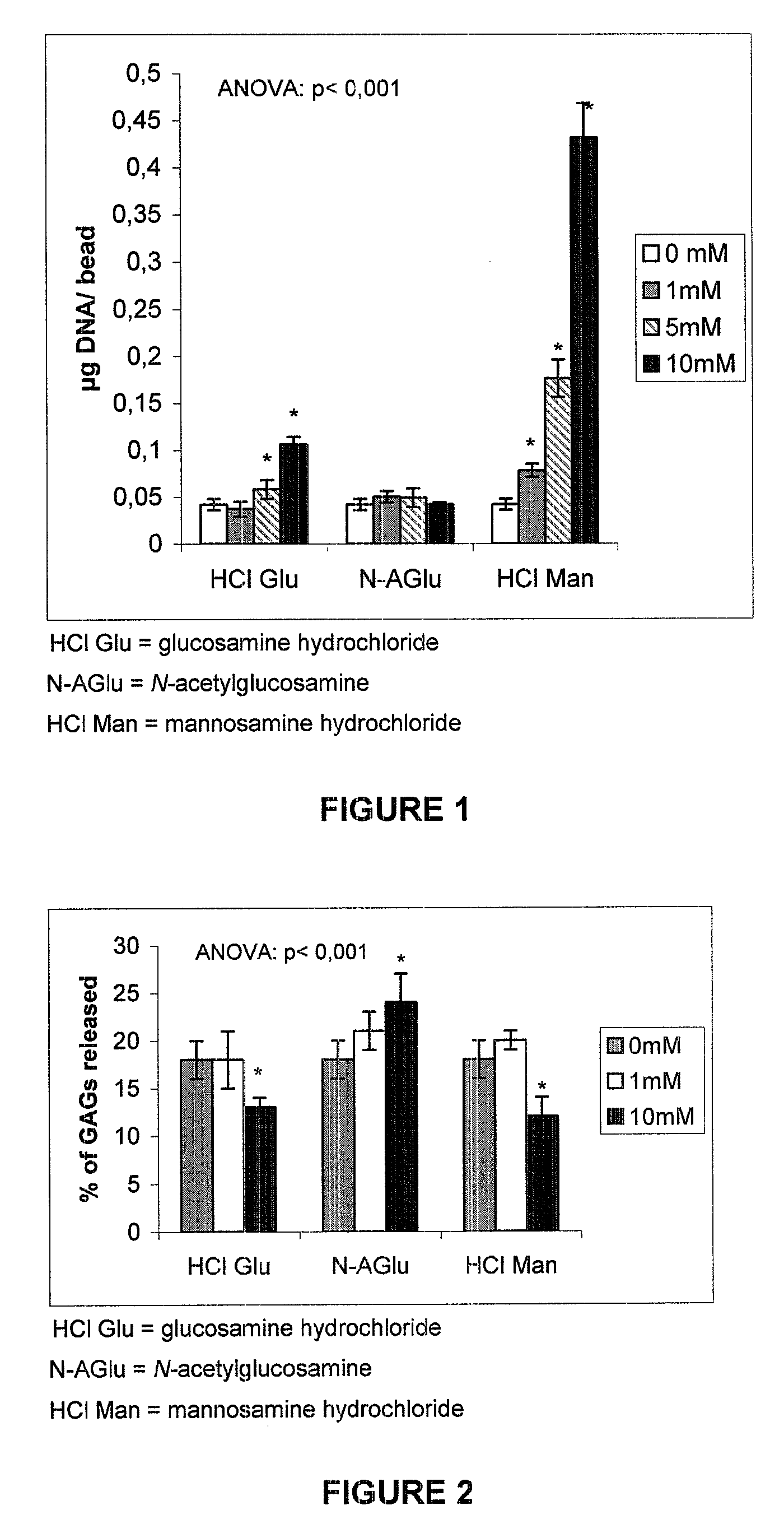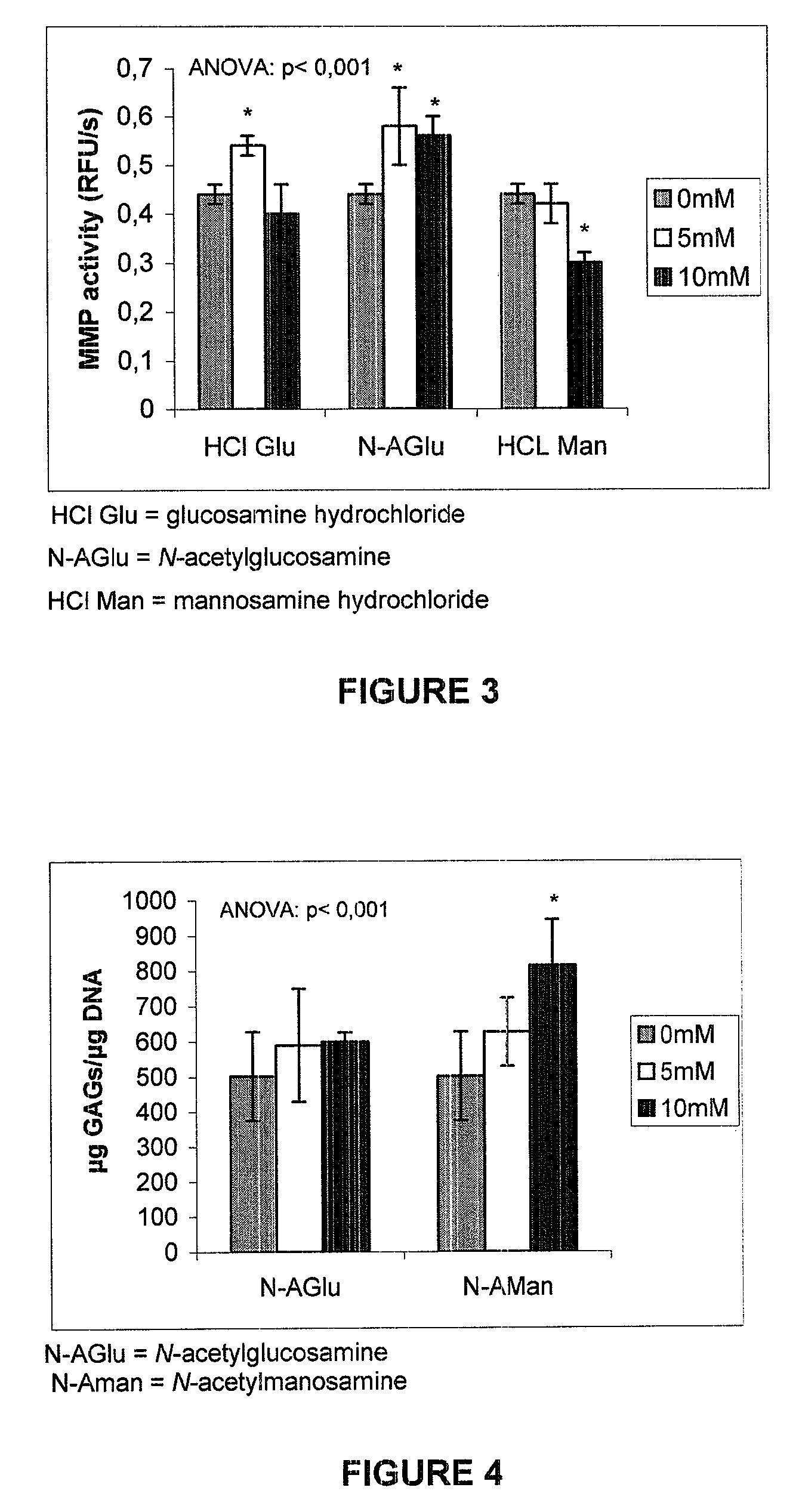Process for cell proliferation
a cell proliferation and process technology, applied in the field of cell proliferation, can solve the problems of limited regeneration capacity of cartilage, pain, swelling and loss of movement in the joint, and difficulty in resolving chondral lesions, and achieve the effects of reducing the release of gags, increasing the synthesis of gags, and increasing the proliferation of chondrocytes
- Summary
- Abstract
- Description
- Claims
- Application Information
AI Technical Summary
Benefits of technology
Problems solved by technology
Method used
Image
Examples
example 1
Proliferation of Chondrocytes Measured Through DNA Levels
[0065]The objective was to determine the effect of mannosamine hydrochloride on chondrocyte proliferation in an in vitro culture model.
[0066]The activity of mannosamine hydrochloride was compared with the following compounds: glucosamine hydrochloride and N-acetylglucosamine.
[0067]The increase in deoxyribonucleic acid (DNA) levels was determined to quantify the increase in chondrocytes,
[0068]Materials and Methods
[0069]Chondrocytes of bovine origin were isolated using digestion with collagenase following a previously described process (B. Beekman et al., Exp. Cell Res., 237, 135-141 (1997)).
[0070]The isolated bovine chondrocytes were cultured following a methodology described in the literature (J. DeGroot, et al., 266, 303-310 (2001)). The chondrocytes were transferred to an alginate support matrix, forming alginate beads which contain the cells at a concentration of 2.5×106 cells / ml, and DMEM (Dulbecco's Modified Eagle's Mediu...
example 2
Release of Glycosaminoglycans from the Chondrocytes in Alginate Beads
[0078]The objective was to determine the effect of mannosamine hydrochloride on the release of glycosaminoglycans (GAGs) from the chondrocytes in alginate beads, after stimulation with IL-1β.
[0079]GAG release is a test used to evaluate the effects of the compounds on proteoglycan degradation induced by IL-1β in the chondrocytes. It permits to evaluate the catabolic activity of the chondrocytes. The release of GAGs induced by IL-1β is mainly mediated by aggrecanases.
[0080]The activity of mannosamine hydrochloride was compared with the following compounds: glucosamine hydrochloride and N-acetylglucosamine.
[0081]Materials and Methods
[0082]Chondrocytes of bovine origin were cultured for 21 days in alginate beads as support matrix; approximately 100 beads in 75 cm2 culture dishes in 25 ml of medium, without adding the compounds to be tested. The medium was regenerated twice a week. After 21 days of culture, the beads we...
example 3
Inhibition of Metalloprotease Activity
[0089]The objective was to determine the effect of mannosamine hydrochloride on metalloprotease activity of the chondrocytes in alginate beads, after stimulation with IL-1β.
[0090]The metalloprotease activity is used to evaluate the effects of the compounds on the release of metalloproteases (MMPs) induced with IL-1β in the chondrocytes. It is a useful test to evaluate the catabolic activity of the chondrocyte. Metalloproteases are secreted by the chondrocytes as inactive pro-enzymes and are previously activated using APMA (4-aminophenyl mercury acetate).
[0091]The first cause of pathological destruction of the cartilage is high proteolytic activity. Metalloproteases are a type of enzyme which degrade the extracellular matrix of the articular cartilage. These enzymes have great capacity to degrade the triple helix of the collagen. High levels of collagenases have been found in patients with osteoarthritis and also a relation between those levels a...
PUM
| Property | Measurement | Unit |
|---|---|---|
| temperature | aaaaa | aaaaa |
| biocompatible | aaaaa | aaaaa |
| composition | aaaaa | aaaaa |
Abstract
Description
Claims
Application Information
 Login to View More
Login to View More - R&D
- Intellectual Property
- Life Sciences
- Materials
- Tech Scout
- Unparalleled Data Quality
- Higher Quality Content
- 60% Fewer Hallucinations
Browse by: Latest US Patents, China's latest patents, Technical Efficacy Thesaurus, Application Domain, Technology Topic, Popular Technical Reports.
© 2025 PatSnap. All rights reserved.Legal|Privacy policy|Modern Slavery Act Transparency Statement|Sitemap|About US| Contact US: help@patsnap.com


